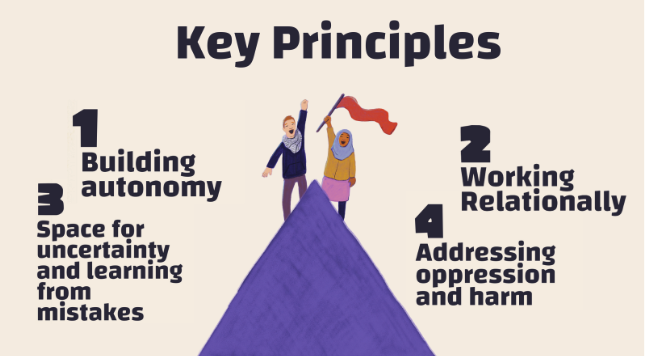Resources
The Shape of Safety – a New Resource on Reimagining Safeguarding
A guidebook to support those working with young people to safeguard in more trauma-informed ways
Latifa Akay | 16 Sep 2024

We are delighted to be launching The Shape of Safety, an online guidebook to reimagining safety and safeguarding alongside young people with experience of mental ill-health, trauma and distress.
This publication is the result of a collaborative project by Act Build Change and National Survivor User Network (NSUN) in partnership with Revoke, a grassroots organisation advocating for the rights and welfare of displaced young people, and Voice Collective, a project that supports young people who hear voices, see visions, or have other sensory experiences or beliefs.
You can download and read the guidebook here: The Shape of Safety 2024.
About the guide
The Shape of Safety is a guidebook to support those working with young people to approach safeguarding in more trauma-informed ways. All too often young people with experience of mental ill-health, trauma and distress are failed and harmed by the safeguarding systems that are supposed to keep them safe. This guide includes tools and principles, reflective questions, and a practitioner’s checklist designed to support those working alongside young people who want to move their safeguarding practice and organisational cultures to become more collaborative, trauma-informed and anti-oppressive.
Act Build Change and NSUN held workshops on reimagining safeguarding with staff and young people from Revoke and Voice Collective, and have presented the insights from these workshops in this guide.
'The Shape of Safety' shares and celebrates methods of fostering cultures of safety and care that foreground lived experience, young people’s agency and anti-oppressive practice. The guide names tensions and challenges that arise in this work, and shares approaches to help navigate them.
This project was funded by Blagrave Trust. The guidebook was illustrated by Marcela Terán.
Who is the guide for?
This guidebook is relevant to anyone working with young people and responsible for their safeguarding and duty of care.
It can be used to start conversations about safeguarding processes in many contexts, for those supporting others of any age, from grassroots user-led groups approaching safeguarding for the first time to larger charities and institutions with already-established safeguarding processes.
How to use the guide
The Shape of Safety guidebook includes principles and tools for better practice, reflective questions, and a checklist that can support practitioners to strengthen cultures of care in their own organisations.
We recommend that where possible you explore this guidebook with peers or colleagues.
Each section of the guide includes reflective questions to support practitioners to think through practices in their own contexts. We encourage readers to really sit with these questions - both individually and with peers. We use reflective questions because there are no clear-cut 'answers' to many safeguarding concerns or challenges. If we find ourselves looking for clear-cut answers in safeguarding we will likely be overlooking the voices and experiences of the young people we work with. This will mean it is more likely that safeguarding measures will be ineffective or cause further harm to young people.
What does the guide contain?
The guide explores the following principles and themes for creating safer practices and cultures:
- Building autonomy - building power by sharing knowledge; the importance of transparency and boundaries; avoiding false empowerment.
- Working relationally - consideration of lived experience; seeing people, not problems or stereotypes; cultivating broad support networks.
- Space for uncertaining and learning from mistakes - differentiating between emergency and discomfort; working collectively, with support for staff and a non-punitive ethos; extending that non-punitive ethos to young people.
- Addressing oppression and harm - acknowledging the realities of young people’s lives; resisting harm in safeguarding practice; building solidarity to shift power.
